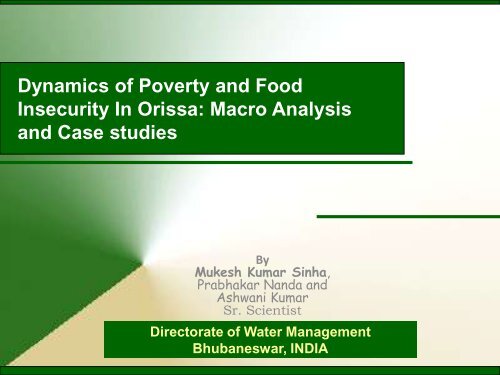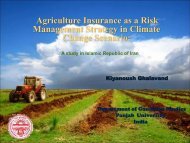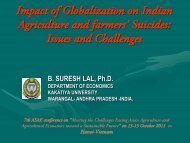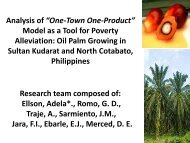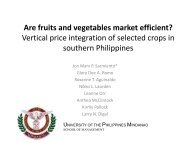Dynamics of Poverty and Food Insecurity In Orissa: Macro Analysis ...
Dynamics of Poverty and Food Insecurity In Orissa: Macro Analysis ...
Dynamics of Poverty and Food Insecurity In Orissa: Macro Analysis ...
Create successful ePaper yourself
Turn your PDF publications into a flip-book with our unique Google optimized e-Paper software.
<strong>Dynamics</strong> <strong>of</strong> <strong>Poverty</strong> <strong>and</strong> <strong>Food</strong><br />
<strong><strong>In</strong>security</strong> <strong>In</strong> <strong>Orissa</strong>: <strong>Macro</strong> <strong>Analysis</strong><br />
<strong>and</strong> Case studies<br />
By<br />
Mukesh Kumar Sinha,<br />
Prabhakar N<strong>and</strong>a <strong>and</strong><br />
Ashwani Kumar<br />
Sr. Scientist<br />
Directorate <strong>of</strong> Water Management<br />
Bhubaneswar, INDIA
Background<br />
POVERTY IN INDIA<br />
1947: 60 percent <strong>of</strong> the population living below the poverty line.<br />
Today, came a long way its drive towards struggle against<br />
chronic poverty, faster economic growth <strong>and</strong> human capitals.<br />
As per planning Commision estimates<br />
population grew from 350 million to 1.20 billion,<br />
food production went up from 55 to 230 million tones;<br />
literacy increased from 18 to 65 percent <strong>and</strong><br />
life expectancy improved from 32 to 67 years .<br />
<strong>Poverty</strong>... in recent years has declined substantially. The steady decline from mid-<br />
1960s to early 1980s was strongly associated with agricultural growth<br />
• Since then, the causes for the decline are attributed more to the increasing nonfarm<br />
wages <strong>and</strong> employment,<br />
• Govt.spending on poverty alleviation program has also registered phenomenal<br />
increase <strong>and</strong> thus benefited the poor <strong>and</strong> the marginalized to a large extent
<strong>Poverty</strong> Estimate approach<br />
TWO approaches:<br />
head count ratio that quantifies income poverty <strong>and</strong><br />
poverty line concept based on minimum calorie intake.<br />
• However, both have their own merits- eg.<br />
poverty line is closely connected to<br />
food insecurity <strong>and</strong> depth <strong>of</strong> hunger<br />
while head count ratio is interpreted<br />
more in terms <strong>of</strong> livelihood opportunity.<br />
• And these two approaches,<br />
have been providing valuable insights for overall dynamics <strong>of</strong> poverty
Extent <strong>of</strong> <strong>Poverty</strong> <strong>and</strong> Regional Spread<br />
Period Rural Urban Total<br />
1973-74<br />
Million<br />
261.0 60.0 321.0<br />
Ratio<br />
50.4 49.0 54.9<br />
1983<br />
Million<br />
262.0 71.0 323.0<br />
Ratio<br />
46.7 40.8 44.5<br />
1993-94<br />
Million<br />
244.0 75.0 320.0<br />
Ratio<br />
37.3 32.4 38.0<br />
1999-00<br />
Million<br />
193.0 67.0 250.0<br />
Ratio<br />
21.1 23.6 26.1<br />
2004-05<br />
Ratio<br />
21.80 21.70 21.80
<strong>Orissa</strong><br />
Poor most state <strong>of</strong> <strong>In</strong>dian Union,<br />
located in the East Coast <strong>of</strong> <strong>In</strong>dia.<br />
Economically backward though<br />
resourceful in many fields.<br />
Frequently attacked by multifarious<br />
disasters like flood, drought <strong>and</strong><br />
cyclone due to its geo-physical<br />
locations.<br />
Agriculture is the mainstay <strong>of</strong> the<br />
people with involvement <strong>of</strong> about<br />
85% population.<br />
‣
Data used for analysis<br />
Various Rounds <strong>of</strong> NSS data used<br />
for <strong>Macro</strong> <strong>Analysis</strong><br />
Published anf Unpublished state<br />
Govt. data were also used<br />
Micro data from the VLS Project<br />
spread over two district has used.<br />
Dhenkanal from central Table L<strong>and</strong><br />
Balangir district From the KBK<br />
poverty Pockets used for the study
<strong>In</strong>cidence <strong>of</strong> <strong>Poverty</strong> in <strong>Orissa</strong> <strong>and</strong> <strong>In</strong>dia<br />
1973-74 to 2004-05
<strong>In</strong>cidence <strong>of</strong> poverty by NSS Regions,<br />
Rural <strong>Orissa</strong>: 2004-05, 1999-00, 1993-94
Social group wise <strong>Poverty</strong> <strong>In</strong>cidence in <strong>Orissa</strong><br />
1973-74 to 2004-05
<strong>In</strong>cidence <strong>of</strong> Poor <strong>and</strong> Calorie Poor<br />
across Regions in <strong>Orissa</strong>, 2004-05<br />
Rural<br />
Urban<br />
Region Head count Share Head count Share<br />
Poor<br />
(%)<br />
Cal<br />
poor<br />
(%)<br />
Popula<br />
tion<br />
(%)<br />
Poor<br />
(%)<br />
Calorie<br />
Poor<br />
(%)<br />
Poor<br />
(%)<br />
Cal<br />
poor<br />
(%)<br />
Popula<br />
tion<br />
(%)<br />
Poor<br />
(%)<br />
Calorie<br />
Poor<br />
(%)<br />
Coastal 27.4 64.6 46.4 27.1 40.1 44.1 40.5 49.8 49.1 40.9<br />
Southern 72.7 91.5 18.6 28.9 22.8 55.0 64.4 10.0 12.4 13.1<br />
Northern 59.1 79.1 35.0 44.0 37.0 42.9 56.5 40.1 38.5 46.0<br />
Poor: Monthly per capita exp below poverty line<br />
Cal Poor: Below 2400 cal per capita in rural area <strong>and</strong> 2100 cal in urban area
State wise monthly per capita expenditure<br />
(NSS 63rd round)
State wise monthly per capita expenditure<br />
(NSS 63rd round)
Rural Urban Gap with respect to<br />
per capita expenditure
Engel’s Ratio, <strong>Orissa</strong> Versus All <strong>In</strong>dia<br />
Share <strong>of</strong> <strong>Food</strong> to total expenditure: <strong>In</strong>dicator for St<strong>and</strong>ard <strong>of</strong> Living<br />
Table Reveals that Ratio <strong>of</strong> Urban <strong>and</strong> Rural <strong>Orissa</strong> is higher than<br />
national level
Status <strong>of</strong> main <strong>and</strong> marginal workers<br />
Share <strong>of</strong> Cultivators/ ag. Workers have sharpely declined in<br />
main worker, appears to shift from ag/allied activities
Net Area Sown in <strong>Orissa</strong> 2001-09
Yield Gap in Rice Production
Agricultural Productivity <strong>In</strong>dicator<br />
for <strong>In</strong>dia <strong>and</strong> <strong>Orissa</strong><br />
AGRI. <strong>In</strong>dicators <strong>Orissa</strong> <strong>In</strong>dia<br />
Per capita food<br />
production in Kg<br />
164 209<br />
Rice Yield<br />
Kg/ha<br />
1210 1930<br />
<strong>Food</strong> Grain Yield<br />
10.8 16.2<br />
Qt/ha<br />
Source: Directorate <strong>of</strong> <strong>Food</strong> Production <strong>and</strong> Statistics, <strong>Orissa</strong><br />
Directorate <strong>of</strong> economics <strong>and</strong> statistics, MOA,GOI
Health <strong>and</strong> Nutrition <strong>In</strong>dicators for Women<br />
<strong>and</strong> Children in orissa
Social Categories classified<br />
Extremely <strong>Food</strong> <strong>In</strong>secure<br />
Source: <strong>Poverty</strong> Task Force, Govt. <strong>of</strong> <strong>Orissa</strong> 2004
Livelihood groups in <strong>Orissa</strong>
Natural Disasters <strong>and</strong> Frequesncy<br />
CYCLONE FLOOD DROUGHT<br />
1990 1992 1993<br />
1994 1996<br />
1996 1995 1998<br />
1999 2003 2000<br />
2005 2001<br />
2008 2002<br />
2008<br />
2011 2011
<strong>Poverty</strong> indicators <strong>of</strong> the study districts<br />
Particulars<br />
Health<br />
<strong>In</strong>dex<br />
<strong>In</strong>come<br />
<strong>In</strong>dex<br />
Educatio<br />
n <strong>In</strong>dex<br />
Human<br />
D. <strong>In</strong>dex<br />
HDI<br />
Rank<br />
Bolangir 0.468 0.504 0.666 6.546 21<br />
Dhenkanal 0.468 0.534 0.773 0.541 12<br />
<strong>Orissa</strong> 0.468 0.545 0.723 0.579 30
Major Agriculture indicators in Study Area<br />
Particulars<br />
Rain fall<br />
(mm)<br />
Cropping<br />
<strong>In</strong>dex (%)<br />
<strong>Poverty</strong> ratio<br />
(percent)<br />
Bolangir 1289.8 140 48.79<br />
Dhenkanal 1428.8 161 47.53<br />
<strong>Orissa</strong> 1451.2 158 46.46
Agro economic indicators <strong>of</strong> <strong>Orissa</strong><br />
( area in 000’ha)<br />
Districts<br />
Normal<br />
rainfall<br />
(mm)<br />
Geographical<br />
Area<br />
Cultiv<br />
ated<br />
Area<br />
GCA<br />
Area<br />
Croppi<br />
ng<br />
<strong>In</strong>tensit<br />
y (%)<br />
Net Irr.<br />
Area<br />
Gross<br />
Irrigated<br />
Area<br />
<strong>Poverty</strong><br />
Ratio<br />
Dhenkan<br />
al<br />
1421.1 460 227 293 147 35.75 50.22 47.53<br />
1443.5 655 338 449 136 41.75 75.95 48.79<br />
Bolangir<br />
Total<br />
<strong>Orissa</strong><br />
1502.6 15571 6420 141<br />
152 2231 3318.15 46.40
Distribution <strong>of</strong> Operational Holdings<br />
Size-Class 1990-91 2000-2002<br />
Farmer class<br />
category<br />
Operation al<br />
Holdings (%)<br />
% tage Area Operational<br />
Holdings<br />
(%)<br />
%tage Area<br />
Marginal 53.6 19.7 56.4 22.7<br />
Small 26.2 26.9 27.4 30.4<br />
Semi Medium 15.2 29.5 12.3 26.5<br />
Medium 4.7 19.1 3.6 16.1<br />
Large 0.4 4.8 0.3 4.3<br />
Total 100 100 100 100<br />
Gini Coeff 0.4456 0.4318<br />
Source: Govt. Of <strong>Orissa</strong>, 2007
Farm size l<strong>and</strong>holding in the study village<br />
Particulars Sogar CPur Ainlatunga Bilaikani<br />
Size <strong>of</strong> l<strong>and</strong> holding<br />
(acre)<br />
1.45 1.82 2.09 3.16<br />
Operated l<strong>and</strong> (acre) 1.03 1.23 1.80 3.14<br />
% irrigated area 6.87 0.00 27.08 27.74<br />
% permanent fallow 18.44 28.43 11.66 4.42
Total population by livestock species (no.)<br />
Farm Animal Sogar CPur Ainlatunga Bilaikani<br />
Cattle 500 495 255 241<br />
Buffalo 26 50 52 20<br />
Goat 79 124 113 198<br />
Sheep 0 0 56 11<br />
Poultry 1 300 74 303<br />
Other 20 2 0 6
Average size <strong>of</strong> livestock holding (no.)<br />
Particulars Sogar CPur Ainlatunga Bilaikani<br />
Cattle 1.17 1.64 0.83 1.41<br />
Buffalo 0.06 0.17 0.17 0.12<br />
Goat 0.18 0.41 0.37 1.16<br />
Sheep 0.00 0.00 0.18 0.06<br />
Poultry 0.00 0.99 0.24 1.77<br />
Other 0.05 0.01 0.00 0.04
Ownership <strong>of</strong> livestock across<br />
household class<br />
L<strong>and</strong><br />
holding<br />
Cattle Buffalo Sheep <strong>and</strong><br />
Goat<br />
Pig<br />
Poultry<br />
L<strong>and</strong> Less 8.62 0.0 25.08 0.0 44.66<br />
Marginal 64.79 22.75 51.04 25.49 39.49<br />
Small 17.73 28.57 11.37 31.37 8.01<br />
Semi<br />
Medium<br />
5.83 14.29 8.26 31.37 4.53<br />
Medium 2.64 33.33 3.43 11.76 2.49<br />
Large 0.22 1.06 0.47 0.00 0.82
Average number <strong>of</strong> farm implements (no.)<br />
Particulars Sogar CPur Ainlatunga Bilaikani<br />
Tractor 0.01 0.01 0.00 0.02<br />
Harvester &<br />
Threshers<br />
0.00 0.00 0.00 0.00<br />
Irrigation motor 0.11 0.05 0.04 0.15<br />
Sprinkler <strong>and</strong><br />
drip irrigation<br />
0.03 0.00 0.00 0.00<br />
Bore well 0.00 0.01 0.00 0.02
Age wise demographic distribution among<br />
sample household (no.)<br />
Age group Sogar CPur Ainlatunga Bilaikani<br />
Below 5 years 162 153 80<br />
6 to 16 years 379 240 127<br />
17 to 30 years 596 301 209<br />
31 to 60 years 780 404 285<br />
Above 60 years 131 98 65
<strong>In</strong>cidence <strong>of</strong> tenancy in the sample household<br />
Particulars Sogar CPur Ainlatunga Bilaikani<br />
Percent household leasing l<strong>and</strong> (%)<br />
Lease-in<br />
14.95 14.57 1.30 4.09<br />
Lease-out<br />
17.06 11.92 1.95 2.92<br />
Share in operated l<strong>and</strong><br />
Lease-in 26.75 18.94 0.56 3.43<br />
Lease-out 43.00 25.62 2.89 4.19
Percentage Occupation diversification<br />
Particulars Sogar CPur Ainlatunga Bilaikani<br />
% working population 35.7 41.28 48.66 35.23<br />
Share <strong>of</strong> particulars in total working population<br />
Cultivator 20.96 40.44 65.00 58.09<br />
Agricultural worker 6.89 13.11 10.89 16.18<br />
Non-Farm worker 47.54 32.60 21.07 21.69<br />
Government Job 11.39 13.11 1.25 2.94<br />
Other 13.22 0.73 1.79 1.10
<strong>In</strong>cidence <strong>of</strong> migration (%)<br />
Particulars Sogar CPur Ainlatunga Bilaikani<br />
% people living<br />
outside the village<br />
Purpose <strong>of</strong> living outside the village<br />
14.67 12.57 1.84 10.88<br />
Education 19.77 16.77 4.55 10.71<br />
Salaried job 49.81 49.10 13.64 5.95<br />
Daily wage<br />
Employment<br />
6.08 13.17 81.82 55.95<br />
Own business 13.69 1.20 0.00 2.38<br />
Searching job 0.00 0.60 0.00 0.00<br />
Other 10.65 19.16 0.00 25.00
Debt credit schedule (Finacial Position)<br />
Ailatunga CPUR Sogar Bilaikani<br />
Borrowing 302400 743800 1270878 412878<br />
Lending 25000 700 20500 150000<br />
saving 101600 297010 1212313 42000<br />
Gr<strong>and</strong> Total 429000 646878 1814634 604878
Sources <strong>of</strong> borrowing<br />
<strong>In</strong>stitutional<br />
sources Ainlatunga Bilaikani Sogar CPur<br />
Commercial bank 107400 0 693000 420000<br />
Co-operative bank 13000 1000 205000 107000<br />
Self help groups(SHG) 0 30228 81000 0<br />
Finance companies 22000 0 77000 26000<br />
Grameen Bank(RRB) 54000 200000 48000 20000<br />
Total(Rs) 196400 231228<br />
110400<br />
0 573000
Non-<strong>In</strong>stitutional sources<br />
Non-<strong>In</strong>stitutional sources<br />
Ainlat<br />
unga<br />
Bilaikan<br />
i Sogar CPur<br />
<strong>In</strong>put supplier 0 0 2000 0<br />
Employer 0 10000 0 0<br />
chit fund 0 0 0 0<br />
L<strong>and</strong>lord 4000 15000 0 0<br />
Moneylender 30000 134500 237500 122600<br />
Other (Specify) 0 0 107000 200<br />
Friends & relatives 47000 10000 187000 28000<br />
Shopkeeper 25000 12150 18000 0<br />
Commission agent 0 0 0 0<br />
TRADERS 0 0 0 20000<br />
Total 106000 181650 551500 170800<br />
Gr<strong>and</strong> Total 302400 412878 1655500 743800
Many things are moving around,<br />
but the paradox is….<br />
Malnutrition still exists<br />
Communication is far from satisfactory<br />
Health problem acute<br />
Education is yet to be manifested<br />
Sebati Pradhan, Ainlatunga<br />
But dreams in eyes <strong>and</strong><br />
.....hope in mind...
Thank you<br />
for your attention !


